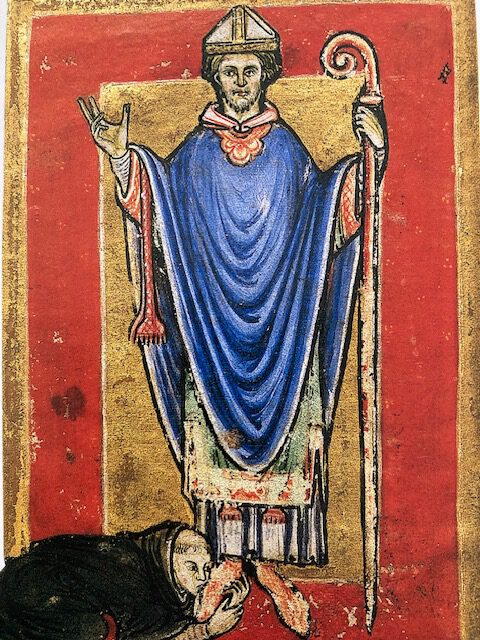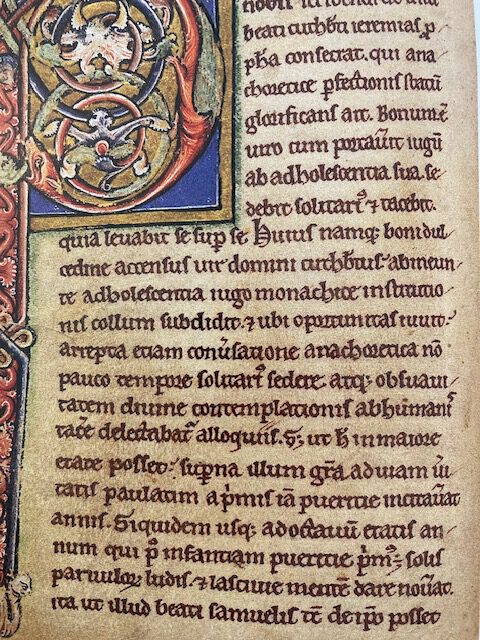
The life of St Cuthbert is surprisingly well documented for a saint of the seventh century. Four “Lives” were written in the years following his death, when the discovery of his incorrupt body led to an upsurge in fervour for the cult of the saint, who had previously only been known as a local man of virtue, and a “miracle-worker”. The first “Life” written by an anonymous source just 11 years after his death, is short, pithy and full of local (Northumbrian) flavour. The responsibility was then passed to St Bede at the Monastery of Jarrow, to give a more ecclesial version of his life – his roles as prior, hermit and bishop are more fully emphasised, and Bede seasons his writings with frequent references to Holy Scripture. His intention is clearly to present Cuthbert as a model of Christ, and worthy of our attention and imitation.
Bede eventually wrote three versions of Cuthbert’s life – the first was poetic – arranged as metrical verses, and then a longer prose life which explored more aspects of Cuthbert’s personality (this is the one that is most usually referenced). Bede also included a brief account of Cuthbert’s influence, en-passant, through the reigns of Oswald and Oswy and the Council of Whitby. You will find it in book III of Bede’s Ecclesiastical History of the English People.
The growing cult of St Cuthbert during the Medieval years, resulted in enthusiastic pilgrimage to the priory at Durham where his body was finally laid to rest. It is likely that the illuminated manuscripts which so charmingly illustrate his life, were produced in the scriptorium there.


The scribe of Durham chose to illustrate a number of the incidents from Bede’s “Life of Cuthbert”. There are 41 extant manuscripts. The book of manuscripts was initially presented (hung around his neck!) to William Fitzherbert, Archbishop of York, when he visited Durham Cathedral to celebrate his cousin, Hugh de Puiset, being installed as Bishop of Durham in 1153.
The manuscripts were eventually collected together again in the nineteenth century by a Master-collector, Henry Yates Thomson (1838-1928), who later donated them to the British Library, where they can be viewed. The Life of Cuthbert is the first British Library manuscript from the Yates Thompson collection to be made available on Digitised Manuscripts. You can find out more here: A Menagerie of Miracles: The Illustrated Life of St Cuthbert – Medieval manuscripts blog (typepad.co.uk)
I am hoping, over the next few months, to explore the spirituality of St Cuthbert, as represented in his life and by the images in the manuscripts, and to explore how we can be guided in our understanding and living of Canon 603 by his teaching and example.
Each “chapter” of Cuthbert’s life which I reference will have a separate post, but I will include a link to all the posts here if that is an easier way for you to follow along. I hope you enjoy getting to know Cuthbert a little more.
For reference: I will be using 4 different abbreviations for my references. Any other references will be supplied in full.
c603: Canon 603 1983
HLPC: The Hermit Life in the Particular Church (Commentary & guidance on C603: Dicastery for Consecrated Life 2022)
AP: The Sayings of the Desert Fathers (Alphabetical Collection) Sr Benedicta Ward 1975
TDF: The Desert Fathers. Sr Benedicta Ward 2003
- Cuthbert in 10
- Prayer: Bede’s Life of Cuthbert III
- Providence: Bede’s Life of Cuthbert V
- Discernment: Bede’s Life of Cuthbert VI
- Hospitality: Bede’s Life of Cuthbert VII
- Friendship: Bede’s Life of Cuthbert VIII
- Penance: Bede’s Life of Cuthbert IX
- Attentiveness: Bede’s Life of Cuthbert X
- Grace: Bede’s Life of Cuthbert XI
- Mutuality: Bede’s Life of Cuthbert: Chapter XII
- Fighting demons: Bede’s Life of Cuthbert: Chapter XIII
- Tabernacle: Bede’s Life of Cuthbert: Chapter XIV
- Emmaus: Bede’s Life of Cuthbert: Chapter XV
- Perseverance : Bede’s Life of Cuthbert: Chapter XVI
The text from Bede’s Life of Cuthbert that is used in this series is part of the Internet Medieval Source Book. The Sourcebook is a collection of public domain and copy-permitted texts related to medieval and Byzantine history. Unless otherwise indicated the specific electronic form of the document is copyright. Permission is granted for electronic copying, distribution in print form for educational purposes and personal use. If you do reduplicate the document, indicate the source. No permission is granted for commercial use. © Paul Halsall June 1997 halsall@murray.fordham.edu
